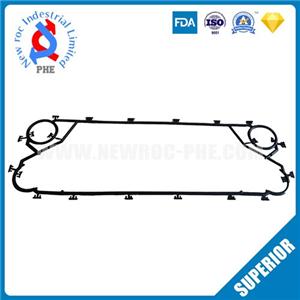Types of Plate Exchanger Leaks
The design of plate heat exchangers is very reliable since they have several fail-safe spots to visibly show any leaks. Nearly all possible leaks will cause the flow to spill out the sides of the exchanger to the ground so the problem becomes obvious.
There are weep-holes in many spots throughout the gasket on all heat exchanger plates that causes the fluid to spill to the ground rather than going unnoticed inside the unit. These weep-holes are in locations that will not see any flow unless a problem has occured. This is to keep your production and utility separated incase of any dangers caused by mixing the two.
The type of external leak created by the weep-holes is a steady stream out of the sides of the plate pack. A leak caused by a misaligned gasket will stream out in a similar way since that part of the plate is seeing your fully pumped process. If your leak is more of a dripping than a stream, that is likely caused by improper tightening of the unit. Measure the length of the plate pack and make sure it is within +/- 1% of the dimension provided by the manufacturer. Closing to the correct dimension will usually fix any dripping leaks. Be sure not to over-tighten as that can damage the plates and gaskets.
If you are noticing a leak at your flanges or connections then you may need to inspect your frame. If your frame gets too corroded then your connection gaskets may have difficulty forming an air-tight seal. This type of leak should be obvious and easily identified as happening between the frame/connection.
The worst case scenario for any exchanger would be cross-contamination of your processes. Luckily this is rare since a severe event would have to occur to allow this. If any of your plates gets a hole punctured in them then the two channels on either side of that plate will come into contact. While this is uncommon, it can occur due to an aggressive chemical, long periods of high temperature/pressure or improper maintenance. This problem can be addressed by using a thicker heat exchanger plate or a double wall or welded unit. Make sure to be aware of your process and its maintenance history, especially in a steam or aggressive chemical service. Also check that your plate pack is in a good alignment since any room to vibrate or rub against adjacent plates will wear down the contact points on all of the plates. A leak caused by punctured plates will be difficult to notice as the unit will not externally leak.
The other way to having your processes mix is a double-gasket failure. Each plate in the heat exchanger will have a diagonal and ring-gasket to block off the flow that is not used in that channel. A simultaneous failure of the ring and diagonal gasket would need to occur for the flow to slip by and drain into the wrong inlet/outlet. Fortunetly, the previously mentioned weep-holes are located in these spots and will result in a visible leak to the outside alerting workers that this unit needs attention. This leak will occur as soon as one of the gaskets has been breached. When you maintenance the unit because of this leak, if the suspect plates seem to have twisted or damaged gaskets you should check your process for any contamination.
The common causes of a leak in your heat exchanger are: improper tightening, incorrect plate installation, pressure surges from your pump, wrong gasket material selection and long periods of use in high pressure/temperature applications. Steam in particular is aggressive on the gasket material and those applications should consider more frequent maintenance and gasket inspection.
If you are experiencing any kind of leakage and are unsure what to do next, New Roc Industry would be glad to help troubleshoot and find a solution for your situation.




